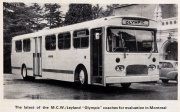Leyland Motors/MCW: Olympic
Note: This is a sub-section of Leyland Motors
The Leyland-MCW Olympic was a successful underfloor-engined single-deck bus built for at least eighteen countries from 1949–71.
3,564 Olympics were built at four factories (two in the UK, one in South Africa) from 1949–71, with 1,299 Olympics built as right hand drive and 2,265 as left hand drive.
In 1948 Leyland and the MCW sales organisation concluded a twenty-year agreement that they would exclusively collaborate on integral designs and favour one another with body-on-chassis business. Their idea was that an underframe comprising durable Leyland engines and other mechanical units would be permanently attached to a similarly heavy-duty body structure. This idea became the Leyland-MCW Olympic and was built over three series from 1949. Only 90 of the early version were registered in the British Isles from 1950-2, but thousands of all marks were sold for export, 1,192 to Cuba alone, the other major customer countries were South Africa, Jamaica, Argentina, Turkey and Uruguay.
The components in the Olympic underframe, to be built at Leyland Motors' Farington works, were mainly as in the Tiger PS2 and Titan PD2, except that the radiator was a fabricated unit designed to fit behind the front axle and below the passenger floor, the rear axle was a new spiral-bevel unit and the engine was horizontally, rather than vertically-oriented.
These units were combined from 1950 with a load-bearing removable chassis to produce the Leyland Royal Tiger (PSU) which was bodied by a large number of coachbuilders including Leyland itself until they shut down their coachworks in 1954.
The Olympic was planned to cover all home and export market requirements for underfloor-engined single deckers over seven variants, with superstructure production shared between two UK plants and one overseas. Nomenclature was based on market, position of driving controls and wheelbase/overall length, the latter dimensions denoted by the number of seats to standard seating plan.
See Also
Sources of Information
- [1] Wikipedia


